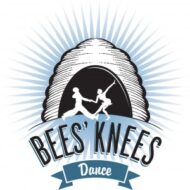Pop by and check out more of our Blog Posts here.
Toronto Dance Instructor, Jasper Palfree, discusses why you should love basic Lindy Hop moves.
Why you should love basic Lindy Hop moves
 While I was in my early stages of learning Lindy Hop, I kept hearing this sentiment over and over:
While I was in my early stages of learning Lindy Hop, I kept hearing this sentiment over and over:
Advanced dancers take beginner lessons.
This is of course a simplification, and really no _advanced_ dancer will improve that much by attending a beginner lesson. It’s more of a saying used to make you think, and get a point across. At the time, I thought I understood entirely what this point was. I thought it meant:
You have to learn to walk before you can run.
I loved the flashy moves. I wanted to learn aerials, floorials, dips, jumps and all of the bells and whistles. The more spins the better. I thought that the idea of advanced dancers taking beginner lessons was saying you need to know your basics so you can progress from there. You need a solid foundation of boring, easy moves to facilitate building up your technique. Sounds reasonable, no?
And it is reasonable. The idea of learning to walking before you can run is true on average… but it’s not the whole story. There’s more. I didn’t understand this until I saw two specific world-class dancers dance; Daniel Heedman & Asa Palm.
In Asa’s words, “Doing swingouts when we practice and dance fast is probably the highest amount of joy that we can feel when it just clicks — because it doesn’t always click. But when it does though it’s… it’s like… I can’t compare it. You just go waa, wee!” 
If you watch Daniel & Asa dance you may well think they do more complex moves than they in fact do. That’s because they bring a certain quality and joy to all of their basic moves. I would probably go as far to say that quality (and joy) can only really emerge from doing the basics. There is more room for musicality, style, character and communication in a tuck turn than in a pancake flip, for example. Some of the best dances are made so not just by using basic moves as a foundation, but instead by highlighting them.
So, maybe you’re still skeptical. I don’t blame you. Some things, you have to see to believe. Allow me to present YouTube. Here is footage of the 2006 Jazz Jam which took place in Stockholm, Sweden. Firstly, there are two videos of the fast and slow precursory round. You may want to watch these a few times. I probably don’t need to point out Daniel & Asa, they’ll probably be the ones that draw your eye most.
In case you have a predisposition towards aerials instead, Daniel & Asa are front and centre in white and red shirts, respectively. Notice that they did one aerial in the entirety of their two dances; the classic A-Jump. Other than that? Tuck turns, Passes, Jigs some basic and tandem charleston, a Barrel Roll, Suzie-Qs, Low downs, some “silly” moves and lots of swingouts. Every move they do, however, is so dynamic… so big… and has so much character. Compare them to the other couples in the back that are busy doing some fancy moves that don’t actually look as big or musical.
Let’s take a look at the finals round where couples get put in the spotlight and show their best stuff. When I watch this I see loads of great dancers, and loads of great musical moves. But none quite match the crispness of Daniel & Asa. Keep a watch on the spectators way in the back. When Daniel & Asa finish their first spotlight they throw their arms up and shout… which is what I sometimes feel like doing while watching this clip.
Every couple pulls out their crazy aerials. But let’s look at what Daniel & Asa’s first spotlight actually consists of:
Swingout, Circle, The Al Mins Hacksaw, tuck turn, single leg charleston kicks, charleston spin, rockstep charleston spin again, Al’s Break (aka. the chase), stop turn, lead spin, the Billy Richter exit move. This definitely contains more complex moves than they performed in the heats, but the moves that aren’t “basic” are still classic lindy hop moves (Two of them were recently taught in the Advanced Lindy Hop Performance Troupe class). What makes them stand out is the amount of confidence and energy they put into every motion. It spreads an atmosphere of utter joy and a sense of “dancing in the moment”. All that said, you won’t be surprised at who won the competition.
